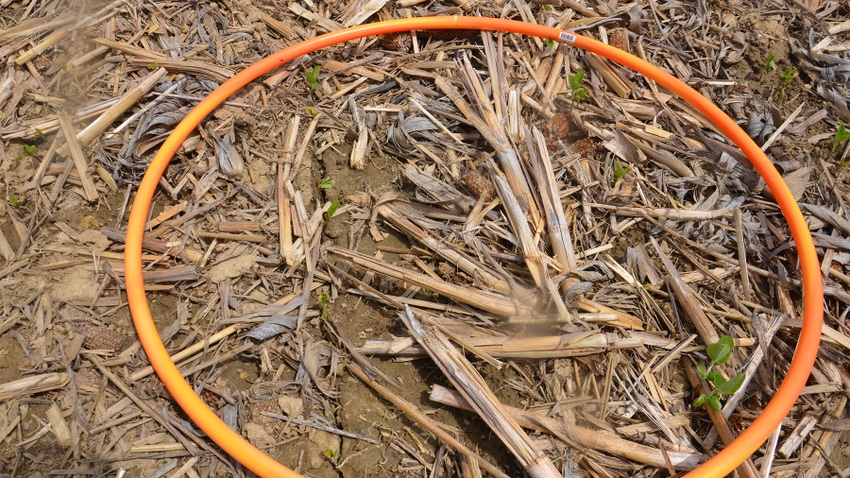April 15, 2024

Row spacing in soybeans is an easy decision for some, but others might wonder if their current spacing is reaching its full potential. While 15-inch rows remain the most popular, there are pros and cons across the board.
Shaun Casteel, Purdue Extension soybean agronomist, says there has been a move toward narrower rows over the decades, but too narrow isn’t necessarily a good thing. He says 15-inch spacing is the sweet spot.
“That really is a nice marriage between the beauty of a planter that does a good job with seed spacing and seed depth,” Casteel says. “Within that, you get pretty good uniform emergence.”
On what Casteel refers to as “normal ground” — ground that has not had any major issues with diseases — there will be a 5% to 10% yield advantage in 15-inch rows compared to 30-inch rows. However, Joe McCutchan, Russellville, Ind., hasn’t noticed any yield difference since he switched to 30-inch rows from a split-row 15-inch planter about 13 years ago.
Benefits of wide rows
McCutchan decided on a 30-inch planter so he could run it for both corn and soybeans, cutting back on equipment costs. He unintentionally conducted an experiment when he happened to have soybean fields in 7.5-inch, 15-inch and 30-inch rows in the same season when switching over equipment. He says he didn’t observe any major yield differences across the different row spacings.
“I couldn’t tell the difference between any of them yield-wise that fall,” McCutchan says. “They were planted around the same time, and I just could not tell the difference between them. I thought, ‘What am I doing? Why am I so concerned?’”
McCutchan explains that all he had heard about for the past decade leading up to then was how narrow rows were the way to go, but that firsthand experience confirmed his decision to switch to a wider row spacing. Since then, he has noticed a host of advantages that continue to validate his practices. For starters, he doesn’t take a yield hit from driving over soybeans in narrower spacings.
“I noticed early on there was a difference in yield when I drove on my beans versus when I didn’t, so that fall I did some yield recordings,” McCutchan says. “I noticed that it was 1½ to 2 bushels per acre by having two tracks every 90 feet with a sprayer in the summer.”
One drawback has been addressed: difficulties associated with cutting 30-inch soybeans. McCutchan says having more sophisticated equipment and GPS makes it possible to cut soybeans on an angle.
“The technology has driven the ability to go back to a 30-inch row, but I went there for the first time 13 years ago because I wanted a bigger planter and didn’t want to own two planters,” McCutchan adds. Using one planter for both corn and soybeans has simplified planting for McCutchan and helped him cut back on costs.
Casteel notes that an additional benefit to 30-inch spacing is its ability to prevent pathogens in susceptible fields. “If you have a wider row and lower plant stand, you have better white mold protection,” he adds.
Drills provide some advantages
On the other end of the spectrum, 7.5-inch spacing in drills allows for early canopy closure that can mitigate weed pressure. Casteel says soybeans in that spacing will typically experience canopy closure 15 days sooner than 15-inch rows, while 15-inch rows close 25 days sooner than 30-inch rows; this means 7.5-inch rows will close 40 days sooner than 30-inch rows.
The other main advantage that Casteel notes is the lower equipment costs associated with drills. The trade-off with that, however, is more money spent on seed. Casteel says drills aren’t nearly as uniform as planters with seed placement, and variability can cause only 60% of the seed planted to establish.
“You’re definitely losing beans because they’re too shallow on top of the ground, and you’re definitely losing beans because they’re too deep,” he adds.
To counter this, Casteel recommends a seeding rate of 175,000 seeds per acre when running a drill as opposed to 140,000 seeds per acre with a planter. He says people operating a drill already understand that they’ll end up going through more seed than with a planter.
“They already know they have to have a higher seeding rate,” Casteel says. “They’re going to spend more money on 35,000 seeds more per acre with that drill, so people have to do the math to weigh the costs.”
Find what works
That math will look different for every producer. It boils down to considering the soil type, equipment, labor and firsthand experiences you are working with to find which spacing will work best.
If you’re following university data and recommendations, Casteel says he would place 15-inch, 20-inch and twin 30-inch rows in the same category of top yielders. Ultimately, McCutchan explains to not be swayed by the row spacings that other people are using.
“To me, your spacing is about what fits you, your economic status, your acreage, your personality,” McCutchan adds. “There are so many things to weigh. It’s not just ‘well, I think 20-inch rows could make 1 more bushel.’ There’s so much more involved, and that’s just one small piece.”
About the Author(s)
You May Also Like






